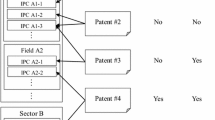Abstract
Technology standardization and technology development interact intimately. Understanding these interactions is fundamental to being able to seek the right solutions to questions about stimulating the advance of science and technology. After analyzing the impact that technology standardization and technology development have on each other, this paper asserts that coupling effects exist between technology standardization and technology development. A coupling model is proposed to examine the mechanism of the interaction between technology standardization and technology development. A seven-level scale for measuring coupling degrees is developed, as well. Furthermore, data from 38 industries in China are collected, in order to validate the proposed model. The newly developed scale is adopted to measure the degree of coupling in the selected industries. Finally, these industries are categorized into three groups based on their coupling degree values. Strategies about how to improve the coupling effects between technology standardization and technology development for each category are provided.
Similar content being viewed by others
References
Acemoglu D, Gancia G, Zilibotti F (2012) Competing engines of growth: innovation and standardization. J Econ Theory 147(2):570–601
Allen RH, Sriram RD (2000) The role of standards in innovation. Technol Forecast Soc Change 64(2):171–181
Antonelli C (1994) Localized technological change and the evolution of standards as economic institutions. Inf Econ Policy 6(3):195–216
Besen SM, Farrell J (1994) Choosing how to compete: strategies and tactics in standardization. J Econ Perspect 8:117–131
Belleflamme P (2002) Coordination on formal vs. de facto standards: a dynamic approach. Eur J Polit Econ 18(1):153–176
Blind K (2004) The economics of standards: theory, evidence, policy. London: Edward Elgar Publications
Chen CS, Liu CH (2008) An empirical study of the inherent dependence between standardization and technology progress. Res Financ Econ Issues 12:37–40
Chen X, He Y, Huang H (2011) An approach to automatic development of interlocking logic based on statechart. Enterp Inf Syst 5(3):273–286
David PA, Greenstein S (1990) The economics of compatibility standards: an introduction to recent research 1. Econ Innov New Technol 1(1–2):3–41
David PA, Steinmueller WE (1996) Standards, trade and competition in the emerging global information infrastructure environment. Telecommun Policy 20(10):817–830
Egyedi TM (2007) Standard-compliant, but incompatible?! Comput Stand Interfaces 29(6):605–613
Eto M (2010) Promotion and obstacles in testing standards innovations. In: Technology management for global economic growth (PICMET), 2010 proceedings of PICMET’10, IEEE, pp 1–11
Farrell J, Saloner G (1986) Installed base and compatibility: innovation, product preannouncements, and predation. Am Econ Rev 76:940–955
Fomin V, Keil T, Lyytinen K (2008) Theorizing about standardization: integrating fragments of process theory in light of telecommunication standardization wars. All Sprouts Content. Paper 45. http://aisel.aisnet.org/sprouts_all/45
Fransman M (1998) Convergence, the Internet and multimedia: implications for the evolution of industries and technologies. JETS Paper-University of Edinburgh Institute for Japanese European Technology Studies
Friedrich J (2011) Making innovation happen: the role of standards and openness in an innovation-friendly ecosystem. In: Proceedings of 2011 7th international conference on standardization and innovation in information technology, Berlin, pp 1–8
Funk JL (2003) Standards, dominant designs and preferential acquisition of complementary assets through slight information advantages. Res Policy 32(8):1325–1341
Funk JL, Methe DT (2001) Market-and committee-based mechanisms in the creation and diffusion of global industry standards: the case of mobile communication. Res Policy 30(4):589–610
Jakobs K, Proctor R, Williams R (2000) Standardization, innovation and implementation of information technology. Comput Netw Age Glob 57:201
Jho W (2007) Global political economy of technology standardization: a case of the Korean mobile telecommunications market. Telecommun Policy 31(2):124–138
Jiang H, Zhao S, Qiu S, Chen Y (2012) Strategy for technology standardization based on the theory of entropy. Inf Technol Manage 13(4):311–320
Jiang H, Zhao S, Zhang Y, Chen Y (2012) The cooperative effect between technology standardization and industrial technology innovation based on Newtonian mechanics. Inf Technol Manage 13(4):251–262
Jiang H, Zhao S, Wang X, Bi Z (2013) Applying electromagnetic field theory to study the synergistic relationships between technology standardization and technology development. Syst Res Behav Sci 30(3):272–286
Jiang H, Zhao S, Yin K, Yuan Y, Bi Z (2014) An analogical induction approach to technology standardization and technology development. Syst Res Behav Sci 31(3):366–382
Kano S (2000) Technical innovations, standardization and regional comparison—a case study in mobile communications. Telecommun Policy 24(4):305–321
Li CT (2004) Standardization and innovation—source of driving social development. China Stand 5:66–70
Lichtenthaler U (2012) Licensing technology to shape standards: examining the influence of the industry context. Technol Forecast Soc Change 79(5):851–861
Lin YF (2002) Viability, economic transition and reflections on neo-classical economics. Econ Res J 12:005
Liu YB, Li RD, Zhang SZ (2005) Urbanization and ecological environment harmonization of standards and evaluation model. China Soft Sci (5):145–153
Niu N, Jin M, Cheng J (2011) A case study of exploiting firm resource planning requirements. Enterp Inf Syst 5(2):183–206
Swann GP (2000) The economics of standardization. University of Manchester, Manchester
Techatassanasoontorn AA, Suo S (2011) Influences on standards adoption in de facto standardization. Inf Technol Manage 12(4):357–385
Veall MR (1985) On product standardization as competition policy. Can J Econ 18(2):416–425
Viriyasitavat W, Xu LD, Martin A (2012) SWSpec: the requirements specification language in service workflow environments. IEEE Trans Ind Inform 8(3):631–638
Xu LD, Viriyasitavat W, Ruchikachorn P, Martin A (2012) Using propositional logic for requirements verification of service workflow. IEEE Trans Ind Inform 8(3):639–646
Yin Y, Xie J (2011) Reconfigurable manufacturing execution system for pipe cutting. Enterp Inf Syst 5(3):287–299
Acknowledgments
This paper is partially supported by the National Natural Science Foundation of China (NSFC) under Grants No. 71273003. This paper is supported by Science and technology Development Plan of Jilin Province (20130420007).
Author information
Authors and Affiliations
Corresponding author
Rights and permissions
About this article
Cite this article
Jiang, H., Zhao, S., Li, Z. et al. Interaction between technology standardization and technology development: a coupling effect study. Inf Technol Manag 17, 229–243 (2016). https://doi.org/10.1007/s10799-015-0215-7
Published:
Issue Date:
DOI: https://doi.org/10.1007/s10799-015-0215-7




